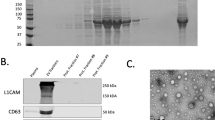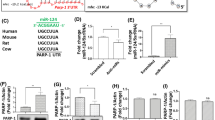Abstract
MicroRNAs (miRNAs) induce messenger RNA (mRNA) degradation and repress mRNA translation. Several miRNAs control the expression of the brain-derived neurotrophic factor (BDNF) in the prefrontal cortex (PFC). The BDNF signaling pathway is activated by moderate intake of alcohol to prevent escalation to excessive drinking. Here, we present data to suggest that the transition from moderate to uncontrolled alcohol intake occurs, in part, upon a breakdown of this endogenous protective pathway via a miRNA-dependent mechanism. Specifically, a mouse paradigm that mimics binge alcohol drinking in humans produced a robust reduction in BDNF mRNA levels in the medial PFC (mPFC), which was associated with increased expression of several miRNAs including miR-30a-5p. We show that miR-30a-5p binds the 3′ untranslated region of BDNF, and that overexpression of miR-30a-5p in the mPFC decreased BDNF expression. Importantly, overexpression of miR-30a-5p in the mPFC produced an escalation of alcohol intake and a preference over water. Conversely, inhibition of miR-30a-5p in the mPFC using a Locked Nucleic Acid sequence that targets miR-30a-5p restored BDNF levels and decreased excessive alcohol intake. Together, our results indicate that miR-30a-5p plays a key role in the transition from moderate to excessive alcohol intake.
This is a preview of subscription content, access via your institution
Access options
Subscribe to this journal
Receive 12 print issues and online access
$259.00 per year
only $21.58 per issue
Buy this article
- Purchase on Springer Link
- Instant access to full article PDF
Prices may be subject to local taxes which are calculated during checkout





Similar content being viewed by others
References
Bartel DP . MicroRNAs: genomics, biogenesis, mechanism, and function. Cell 2004; 116: 281–297.
Schratt GM, Tuebing F, Nigh EA, Kane CG, Sabatini ME, Kiebler M et al. A brain-specific microRNA regulates dendritic spine development. Nature 2006; 439: 283–289.
Gao J, Wang WY, Mao YW, Graff J, Guan JS, Pan et al. A novel pathway regulates memory and plasticity via SIRT1 and miR-134. Nature 2010; 466: 1105–1109.
Im HI, Kenny PJ . MicroRNAs in neuronal function and dysfunction. Trends Neurosci 2012; 35: 325–334.
Li MD, van der Vaart AD . MicroRNAs in addiction: adaptation's middlemen? Mol Psychiatry 2011; 16: 1159–1168.
Pietrzykowski AZ, Friesen RM, Martin GE, Puig SI, Nowak CL, Wynne PM et al. Posttranscriptional regulation of BK channel splice variant stability by miR-9 underlies neuroadaptation to alcohol. Neuron 2008; 59: 274–287.
Li J, Liu X, Qin S, Guan Y, Liu Y, Cheng Y et al. MicroRNA expression profile and functional analysis reveal that miR-382 is a critical novel gene of alcohol addiction. EMBO Mol Med 2013; 5: 1402–1414.
Miranda RC . MicroRNAs and fetal brain development: implications for ethanol teratology during the second trimester period of neurogenesis. Front Genet 2012; 3: 77.
Lewohl JM, Nunez YO, Dodd PR, Tiwari GR, Harris RA, Mayfield RD . Up-regulation of microRNAs in brain of human alcoholics. Alcohol Clin Exp Res 2011; 35: 1928–1937.
Chandrasekar V, Dreyer JL . microRNAs miR-124, let-7d and miR-181a regulate cocaine-induced plasticity. Mol Cell Neurosci 2009; 42: 350–362.
Varendi K, Kumar A, Harma MA, Andressoo JO . miR-1, miR-10b, miR-155, and miR-191 are novel regulators of BDNF. Cell Mol Life Sci 2014 (in press).
Mellios N, Huang HS, Grigorenko A, Rogaev E, Akbarian S . A set of differentially expressed miRNAs, including miR-30a-5p, act as post-transcriptional inhibitors of BDNF in prefrontal cortex. Hum Mol Genet 2008; 17: 3030–3042.
Mellios N, Huang HS, Baker SP, Galdzicka M, Ginns E, Akbarian S . Molecular determinants of dysregulated GABAergic gene expression in the prefrontal cortex of subjects with schizophrenia. Biol Psychiatry 2009; 65: 1006–1014.
Tapocik JD, Barbier E, Flanigan M, Solomon M, Pincus A, Pilling A et al. microRNA-206 in rat medial prefrontal cortex regulates BDNF expression and alcohol drinking. J Neurosci 2014; 34: 4581–4588.
Park H, Poo MM . Neurotrophin regulation of neural circuit development and function. Nat Rev Neurosci 2013; 14: 7–23.
Minichiello L . TrkB signalling pathways in LTP and learning. Nat Rev Neurosci 2009; 10: 850–860.
McGough NN, He DY, Logrip ML, Jeanblanc J, Phamluong K, Luong K et al. RACK1 and brain-derived neurotrophic factor: a homeostatic pathway that regulates alcohol addiction. J Neurosci 2004; 24: 10542–10552.
Jeanblanc J, He DY, McGough NN, Logrip ML, Phamluong K, Janak PH et al. The dopamine D3 receptor is part of a homeostatic pathway regulating ethanol consumption. J Neurosci 2006; 26: 1457–1464.
Jeanblanc J, He DY, Carnicella S, Kharazia V, Janak PH, Ron D . Endogenous BDNF in the dorsolateral striatum gates alcohol drinking. J Neurosci 2009; 29: 13494–13502.
Jeanblanc J, Logrip ML, Janak PH, Ron D . BDNF-mediated regulation of ethanol consumption requires the activation of the MAP kinase pathway and protein synthesis. Eur J Neurosci 2013; 37: 607–612.
Logrip ML, Janak PH, Ron D . Escalating ethanol intake is associated with altered corticostriatal BDNF expression. J Neurochem 2009; 109: 1459–1468.
Kalivas PW, Volkow ND . The neural basis of addiction: a pathology of motivation and choice. Am J Psychiatry 2005; 162: 1403–1413.
George O, Sanders C, Freiling J, Grigoryan E, Vu S, Allen CD et al. Recruitment of medial prefrontal cortex neurons during alcohol withdrawal predicts cognitive impairment and excessive alcohol drinking. Proc Natl Acad Sci USA 2012; 109: 18156–18161.
Paxinos G, Franklin KBJ . The mouse brain in stereotaxic coordinates. Academic press: New York, 2001.
Hollander JA, Im HI, Amelio AL, Kocerha J, Bali P, Lu Q et al. Striatal microRNA controls cocaine intake through CREB signalling. Nature 2010; 466: 197–202.
Warnault V, Darcq E, Levine A, Barak S, Ron D . Chromatin remodeling—a novel strategy to control excessive alcohol drinking. Transl Psychiatry 2013; 3: e231.
Koob GF . Addiction is a reward deficit and stress surfeit disorder. Front Psychiatry 2013; 4: 72.
Hwa LS, Chu A, Levinson SA, Kayyali TM, DeBold JF, Miczek KA . Persistent escalation of alcohol drinking in C57BL/6J mice with intermittent access to 20% ethanol. Alcohol Clin Exp Res 2011; 35: 1938–1947.
NIAAA. Council appoves definition of binge drinking. NIAAA News Lett 2004; 3: 3
Betel D, Wilson M, Gabow A, Marks DS, Sander C . The microRNA.org resource: targets and expression. Nucleic Acids Res 2008; 36: D149–D153.
Dweep H, Sticht C, Pandey P, Gretz N . miRWalk—database: prediction of possible miRNA binding sites by ‘walking’ the genes of three genomes. J Biomed Inform 2011; 44: 839–847.
Chen BT, Yau HJ, Hatch C, Kusumoto-Yoshida I, Cho SL, Hopf FW et al. Rescuing cocaine-induced prefrontal cortex hypoactivity prevents compulsive cocaine seeking. Nature 2013; 496: 359–362.
An JJ, Gharami K, Liao GY, Woo NH, Lau AG, Vanevski F et al. Distinct role of long 3' UTR BDNF mRNA in spine morphology and synaptic plasticity in hippocampal neurons. Cell 2008; 134: 175–187.
Orefice LL, Waterhouse EG, Partridge JG, Lalchandani RR, Vicini S, Xu B . Distinct roles for somatically and dendritically synthesized brain-derived neurotrophic factor in morphogenesis of dendritic spines. J Neurosci 2013; 33: 11618–11632.
Beveridge NJ, Gardiner E, Carroll AP, Tooney PA, Cairns MJ . Schizophrenia is associated with an increase in cortical microRNA biogenesis. Mol Psychiatry 2010; 15: 1176–1189.
Bahi A, Dreyer JL . Striatal modulation of BDNF expression using microRNA124a-expressing lentiviral vectors impairs ethanol-induced conditioned-place preference and voluntary alcohol consumption. Eur J Neurosci 2013; 38: 2328–2337.
Chandrasekar V, Dreyer JL . Regulation of MiR-124, Let-7d, and MiR-181a in the accumbens affects the expression, extinction, and reinstatement of cocaine-induced conditioned place preference. Neuropsychopharmacology 2011; 36: 1149–1164.
Eacker SM, Dawson TM, Dawson VL . The interplay of microRNA and neuronal activity in health and disease. Front Cell Neurosci 2013; 7: 136.
Hopf FW, Martin M, Chen BT, Bowers MS, Mohamedi MM, Bonci A . Withdrawal from intermittent ethanol exposure increases probability of burst firing in VTA neurons in vitro. J Neurophysiol 2007; 98: 2297–2310.
Wang J, Lanfranco MF, Gibb SL, Yowell QV, Carnicella S, Ron D . Long-lasting adaptations of the NR2B-containing NMDA receptors in the dorsomedial striatum play a crucial role in alcohol consumption and relapse. J Neurosci 2010; 30: 10187–10198.
Lovinger DM, Roberto M . Synaptic effects induced by alcohol. Curr Top Behav Neurosci 2013; 13: 31–86.
Pandey SC, Ugale R, Zhang H, Tang L, Prakash A . Brain chromatin remodeling: a novel mechanism of alcoholism. J Neurosci 2008; 28: 3729–3737.
Wolstenholme JT, Warner JA, Capparuccini MI, Archer KJ, Shelton KL, Miles MF . Genomic analysis of individual differences in ethanol drinking: evidence for non-genetic factors in C57BL/6 mice. PloS One 2011; 6: e21100.
Ponomarev I, Wang S, Zhang L, Harris RA, Mayfield RD . Gene coexpression networks in human brain identify epigenetic modifications in alcohol dependence. J Neurosci 2012; 32: 1884–1897.
Stragier E, Massart R, Salery M, Hamon M, Geny D, Martin V et al. Ethanol-induced epigenetic regulations at the Bdnf gene in C57BL/6J mice. Mol Psychiatry 2014 (in press).
Mei S, Liu Y, Bao Y, Zhang Y, Min S, Liu Y et al. Dendritic cell-associated miRNAs are modulated via chromatin remodeling in response to different environments. PloS One 2014; 9: e90231.
McCool BA . Ethanol modulation of synaptic plasticity. Neuropharmacology 2011; 61: 1097–1108.
Luscher C, Malenka RC . Drug-evoked synaptic plasticity in addiction: from molecular changes to circuit remodeling. Neuron 2011; 69: 650–663.
Robison AJ, Nestler EJ . Transcriptional and epigenetic mechanisms of addiction. Nat Rev Neurosci 2011; 12: 623–637.
Enoch MA, Goldman D . Problem drinking and alcoholism: diagnosis and treatment. Am Fam Physician 2002; 65: 441–448.
Nutt DJ, King LA, Phillips LD . Drug harms in the UK: a multicriteria decision analysis. Lancet 2010; 376: 1558–1565.
World Health Organization (WHO). Global Status Report on Alcohol and Health. World Health Organization: Geneva, Switzerland, 2014.
Collins PY, Patel V, Joestl SS, March D, Insel TR, Daar AS et al. Grand challenges in global mental health. Nature 2011; 475: 27–30.
De Smaele E, Ferretti E, Gulino A . MicroRNAs as biomarkers for CNS cancer and other disorders. Brain Res 2010; 1338: 100–111.
Lai CY, Yu SL, Hsieh MH, Chen CH, Chen HY, Wen CC et al. MicroRNA expression aberration as potential peripheral blood biomarkers for schizophrenia. PloS One 2011; 6: e21635.
Kasinski AL, Slack FJ . Epigenetics and genetics. MicroRNAs en route to the clinic: progress in validating and targeting microRNAs for cancer therapy. Nat Rev Cancer 2011; 11: 849–864.
Acknowledgements
We thank Dr Dao Yao He, Ms Melissa Lin, Ms Wenheng Zhu for technical assistance, and Dr Jacob Beckley and Dr Virginia Long for careful review of the manuscript. This research was supported by NIAAA R01 AA016848 (DR), NIAAA R37 AA016848 (DR), NIAAA P50 AA017072 (DR), and the State of California for medical research on alcohol and substance abuse through UCSF (DR).
Author information
Authors and Affiliations
Corresponding author
Ethics declarations
Competing interests
The authors declare no conflict of interest.
Additional information
Supplementary Information accompanies the paper on the Molecular Psychiatry website
Supplementary information
Rights and permissions
About this article
Cite this article
Darcq, E., Warnault, V., Phamluong, K. et al. MicroRNA-30a-5p in the prefrontal cortex controls the transition from moderate to excessive alcohol consumption. Mol Psychiatry 20, 1240–1250 (2015). https://doi.org/10.1038/mp.2014.120
Received:
Revised:
Accepted:
Published:
Issue Date:
DOI: https://doi.org/10.1038/mp.2014.120
This article is cited by
-
Voluntary wheel running during adolescence prevents the increase in ethanol intake induced by social defeat in male mice
Psychopharmacology (2023)
-
The Role of Zinc Status on Spatial Memory, Hippocampal Synaptic Plasticity, and Insulin Signaling in icv-STZ-Induced Sporadic Alzheimer’s-Like Disease in Rats
Biological Trace Element Research (2022)
-
Glycogen synthase kinase 3 beta regulates ethanol consumption and is a risk factor for alcohol dependence
Neuropsychopharmacology (2018)
-
mTORC1-dependent translation of collapsin response mediator protein-2 drives neuroadaptations underlying excessive alcohol-drinking behaviors
Molecular Psychiatry (2017)
-
Viral-mediated overexpression of the Myelin Transcription Factor 1 (MyT1) in the dentate gyrus attenuates anxiety- and ethanol-related behaviors in rats
Psychopharmacology (2017)



